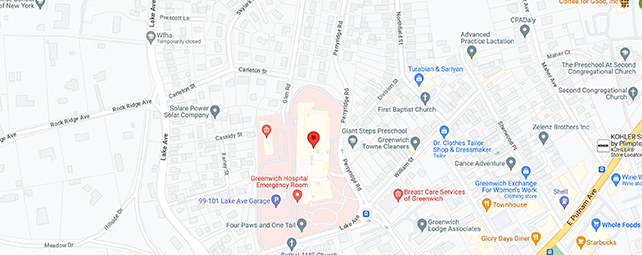Revisional Bariatric Surgery in Stamford, Greenwich Hospital
Although 90% of patients are successful, the revision rate for the laparoscopic adjustable gastric banding procedure is approximately 10% during the first two years following the surgery. This is due to device-related problems or unsatisfactory weight loss. The gastric band can slip which would require a follow-up procedure to correct the problem. Some patients will choose to have the band replaced and others will select a different procedure. Occasionally the port may have to be replaced because of wear and tear. This can be performed with a very small incision under mild anesthesia. Bands that erode into the stomach may need to be removed.
REVISIONS AFTER GASTRIC BYPASS SURGERY
Revisions in gastric bypass patients happen in approximately 5 to 10% of the patients over a 5 year period. This would be due to complications, unsatisfactory weight loss or regaining weight. After gastric bypass surgery complications that may occur include ulcers, chronic vomiting, hernia, and staple line failure. They are usually improved through laparoscopic revisional bariatric surgery. There are several options available to the patient:
If the problem is the lack of the desired excess weight or regaining weight, a non-surgical approach can be taken. This includes regulating eating habits, exercise, nutritional counseling, behavior modification therapy, psychological counseling and support groups.
If the problem is the lack of the desired excess weight or regaining weight, there are surgical options available that include the placement of an adjustable gastric band on the stomach pouch decreasing the size of the stomach or a conversion to distal gastric bypass.
If the stomach pouch or stomach opening has become enlarged we can add a laparoscopic band to reduce the amount of food intake and slow the movement of the food from the stomach to the small intestine. An alternate approach would be to remove more of the stomach or tighten up the stomach to make it smaller.
If the two parts of the stomach reconnect, they can be separated with the use of a stapling device in a revisional procedure.
APOLLO OVERSTITCH: ENDOSCOPIC OUTLET AND POUCH REPAIR
We now offer qualified patients an endoscopic procedure to reduce the volume of an enlarged pouch and the diameter of the outlet. This procedure is performed using a small flexible endoscope and specialized devices that allows sutures to be placed through the endoscope. The scope and suturing devices are inserted through the mouth into the stomach pouch the same way as a standard endoscope. Sutures are then placed around the outlet to reduce the diameter, typically from the size of a silver dollar to the size of a dime. The same technique may then be used to place additional sutures in the stomach pouch to reduce its volume capacity.
Benefits of the endoscopic procedure:
Scarring and adhesions from the initial weight loss surgery procedure often make open or laparoscopic surgery challenging, and sometimes impossible. Abdominal revision surgery takes longer than the original weight loss surgery and patients are more likely to develop complications. Having a revision through endoscopic procedure decreases the patient’s risk when compared to abdominal revision surgery. Patients experience less pain, recover faster, and have no abdominal scarring. Typically patients go home the same day, but each patient’s discharge will vary based on the physician’s recommendation.
LAPAROSCOPIC REVISION: GASTRIC BAND PLACED OVER ROUX-EN-Y GASTRIC BYPASS
There can be situations where the gastric bypass will not lead to optimal weight loss. After surgery, we make every attempt to maximize the weight loss with follow-up visits, nutrition and diet, and exercise. If this doesn’t work and the patient still wants a greater weight loss, the patient has the option of having a laparoscopic adjustable band placed on top of a gastric bypass. The gastric bypass remains intact. These patients derive the benefits of both procedures.
A laparoscopic adjustable silicone band (Realize Band™ or LAP-BAND® system) is placed laparoscopically around the top portion of the stomach. This results in a loss of weight because of the restriction it creates in the amount of food the patient can eat and the decrease in hunger that the patient senses. Unlike other procedures, gastric banding does not require any cutting or removal of any part of the digestive system and is a reversible procedure.
Advantages:
- Less invasive; less pain
- No stapling, cutting, or intestinal rerouting
- Adjustable
- Reversible
- Low complication rate
- Lower morbidity and mortality rate of all revision procedures
Disadvantages:
- Slower initial weight loss than gastric bypass
- Reflux
- Regular follow-up critical for optimal results
- Nausea and vomiting
- Gas and bloating
- Depression and psychological distress
Complications:
- Pulmonary embolism is rare
- Rare band Erosion
- Band slippage less than 5%
- Leakage
- Hemorrhage
- Pneumonia
- Wound and port problems
- Infection
- Urinary Tract Infection
- Lower mortality risk
LAPAROSCOPIC REVISION: CONVERSION OF GASTRIC BAND TO ROUX-EN-Y GASTRIC BYPASS
There can be situations where the gastric band will not lead to optimal weight loss. After surgery, we make every attempt to maximize the weight loss with follow-up visits, nutrition and diet, and exercise. If this doesn’t work and the patient still wants a greater weight loss, the patient has the option of having the band removed and having a gastric bypass performed.
Advantages:
- Weight loss is quicker than the other procedures
- Nothing is left internally that can slip, break or disintegrate
- Longevity of this operation having been done for over 30 years
- Patients have had better results with total weight loss, long-term weight maintenance, and improved health than those who chose other procedures
Disadvantages:
- Slightly higher complication rate than the other procedures
- Longer recovery period
- Dumping syndrome can occur if foods with a sugary content are eaten. This could result in diarrhea, nausea, cramps, cold sweats and chest pain.
- Necessity to take vitamin and mineral supplementation for life
Complications:
- Pulmonary embolism
- Deep vein thrombosis (DVT)
- Leakage from bowel
- Abscess
- Hemorrhage
- Bowel Obstruction
- Obstruction of the Stomach Outlet
- Pneumonia
- Wound Infection
- Urinary Tract Infection
- Chronic Nutritional Problems
- Protein Deficiency
- Vitamin and Mineral Deficiency
- Mortality risk is slightly higher than original bypass depending upon BMI and medical problems
LAPAROSCOPIC REVISION OF A ROUX-EN-Y GASTRIC BYPASS STOMACH POUCH
In some cases, a patient’s stomach pouch and outlet over time will significantly stretch. A new smaller pouch and outlet is created by resecting the existing stomach pouch or revising the stomach outlet to make it smaller. This procedure contributes to weight loss because the patient will once again get the feeling of being full after only a few bites of food.
Advantages:
- Weight loss is quicker than the other procedures
- Nothing is left internally that can slip, break or disintegrate
- Longevity of this operation having been done for over 30 years
- Patients have had better results with total weight loss, long-term weight maintenance, and improved health than those who chose other procedures
Disadvantages:
- Slightly higher complication rate than the other procedures
- Longer recovery period
- Dumping syndrome can occur if foods with a sugary content are eaten. This could result in diarrhea, nausea, cramps, cold sweats and chest pain
- Necessity to take vitamin and mineral supplementation for life.
Complications:
- Pulmonary embolism
- Deep vein thrombosis (DVT)
- Leakage from bowel
- Abscess
- Hemorrhage
- Bowel Obstruction
- Obstruction of the Stomach Outlet
- Pneumonia
- Wound Infection
- Urinary Tract Infection
- Chronic Nutritional Problems
- Protein Deficiency
- Vitamin and Mineral Deficiency
- Mortality risk is 1 in 1000 depending upon BMI and medical problems
LAPAROSCOPIC REVISION: CONVERSION OF ROUX-EN-Y GASTRIC BYPASS TO A LONG LIMB BYPASS (200-300cm)
In some cases, a patient’s stomach pouch and outlet are the optimal sizes and the only alternative is to create a larger amount of small bowel that is bypassed. This will result in more significant malabsorption and weight loss.
Advantages:
- Weight loss is quicker than the other procedures
- Nothing is left internally that can slip, break or disintegrate
- Longevity of this operation having been done for over 30 years
- Patients have had better results with total weight loss, long-term weight maintenance, and improved health than those who chose other procedures
Disadvantages:
- Slightly higher complication rate than the other procedures
- Longer recovery period
- Dumping syndrome can occur if foods with a sugary content are eaten. This could result in diarrhea, nausea, cramps, cold sweats and chest pain
- Higher risk of malnutrition and need for dietary vitamins and supplements
- Necessity to take vitamin and mineral supplementation for life.
Complications:
- Pulmonary embolism
- Deep vein thrombosis (DVT)
- Leakage from bowel
- Abscess
- Hemorrhage
- Bowel Obstruction
- Obstruction of the Stomach Outlet
- Pneumonia
- Wound Infection
- Urinary Tract Infection
- Chronic Nutritional Problems
- Protein Deficiency
- Vitamin and Mineral Deficiency
- Mortality risk is 1 in 1000 depending upon BMI and medical problems
LAPAROSCOPIC TREATMENT OF A GASTRO-GASTRIC FISTULA
Over several years a reconnection can develop between the new stomach and the existing stomach remnant. As a result, the patient would again have a full-size stomach which eventually leads to weight gain over the years. The patient will again feel the restrictions the stomach pouch and will lose a significant amount of weight.
Advantages:
- Weight loss is quicker than the other procedures
- Nothing is left internally that can slip, break or disintegrate
- Longevity of this operation having been done for over 30 years
- Patients have had better results with total weight loss, long-term weight maintenance, and improved health than those who chose other procedures
Disadvantages:
- Slightly higher complication rate than the other procedures
- Longer recovery period
- Necessity to take vitamin and mineral supplementation for life.
- Dumping syndrome can occur if foods with a sugary content are eaten. This could result in diarrhea, nausea, cramps, cold sweats and chest pain
Complications:
- Pulmonary embolism
- Deep vein thrombosis (DVT)
- Leakage from bowel
- Abscess
- Hemorrhage
- Bowel Obstruction
- Obstruction of the Stomach Outlet
- Pneumonia
- Wound Infection
- Urinary Tract Infection
- Chronic Nutritional Problems
- Protein Deficiency
- Vitamin and Mineral Deficiency
- Mortality risk is 1 in 1000 depending upon BMI and medical problems
LAPAROSCOPIC ULCER RESECTION
After having gastric bypass surgery some patients may find themselves developing recurrent ulcers that appear at the gastric outlet. We will prescribe medication and advise the patient to refrain from smoking and drinking alcohol and caffeine. It is infrequent that this method of treatment doesn’t work. However, in the event it doesn’t, the patient can have the ulcer removed laparoscopically and a new stomach outlet created. Occasionally the nerves that produce acid may also need to be ligated.
Advantages:
- Decreased acid production
- Resolution of pain
- Healing of ulcers
- Weight loss is quicker than the other procedures
- Nothing is left internally that can slip, break or disintegrate
Disadvantages:
- Slightly higher complication rate than the other procedures
- Longer recovery period
- Necessity to take vitamin and mineral supplementation for life.
- Dumping syndrome can occur if foods with a sugary content are eaten. This could result in diarrhea, nausea, cramps, cold sweats and chest pain.
Complications:
- Pulmonary embolism
- Deep vein thrombosis (DVT)
- Leakage from bowel
- Abscess
- Hemorrhage
- Bowel Obstruction
- Obstruction of the Stomach Outlet
- Pneumonia
- Wound Infection
- Urinary Tract Infection
- Chronic Nutritional Problems
- Protein Deficiency
- Vitamin and Mineral
You are welcome to call our office and we will supply you with a free insurance evaluation. We are here to assist and support you from your initial decision to the actual surgery and the aftercare for your long-term weight loss. Our staff will carry you through the process and minimize your fears, pressures and help you overcome your concerns.
Dr. Neil Floch and his weight loss surgery team makes the long-term care of your weight loss easy and guides you on a lifelong path to freedom from obesity that is safe, enjoyable and satisfying.
















